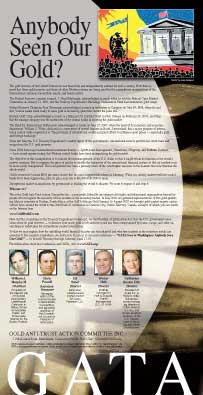You are here
Alex J. Pollock: How can the Fed pay dividends to shareholders when it has no profits?
By Alex J. Pollock
The New York Sun
Saturday, January 11, 2025
Although the Federal Reserve is -- and thinks of itself as -- part of the government, 100% of the $37 billion in paid-in stock of its twelve component Federal Reserve Banks is owned by private shareholders. This was part of the political compromise of the original 1913 Federal Reserve Act.
... Dispatch continues below ...
.... ADVERTISEMENT ....
Buy metals at GoldMoney and enjoy international storage
GoldMoney was established in 2001 by James and Geoff Turk and is safeguarding more than $1.7 billion in metals and currencies. Buy gold, silver, platinum, and palladium from GoldMoney over the Internet and store them in vaults in Canada, Hong Kong, Singapore, Switzerland, and the United Kingdom, taking advantage of GoldMoney's low storage rates, among the most competitive in the industry. GoldMoney also offers delivery of 100-gram and 1-kilogram gold bars and 1-kilogram silver bars.
To learn more, please visit:
http://www.goldmoney.com/?gmrefcode=gata
The shareholders are the commercial banks that are the members of the respective Federal Reserve Banks. Remarkably, these private shareholders are getting dividends from the Reserve Banks even when the combined Fed has no profits, no saved up past profits (retained earnings), and hugely negative actual capital. Any private bank which tried to pay dividends under these circumstances would be sternly prohibited by the Fed from doing so.
For the first nine months of 2024, the Federal Reserve Banks in the aggregate paid more than $1.2 billion in dividends to their shareholders. Yet at the same time, they together posted losses totaling $63 billion. On an annualized basis, they are paying dividends of $1.7 billion, for a dividend yield of about 4.5 percent, while losing about $80 billion, with negative retained earnings and capital. How is that possible -- or ethical -- one might wonder.
The Fed’s performance on this score was even more remarkable in 2023. For that year, the combined federal reserve banks paid $1.5 billion in dividends to the shareholders, while losing the nearly unimaginable sum of $114 billion. That was a loss of 2.6 times the total capital they claim to have.
The Fed’s officers and energetic public relations efforts assert that for the Fed, having negative capital, i.e. being technically insolvent, doesn’t matter. Even were that true, how could it justify paying dividends when there are no profits, past or present, with which to pay them.
As of January 1, 2025, the combined FRBs have accumulated losses of $216 billion from losing money in every single month since October 2022. In proper and obvious accounting, one subtracts losses from retained earnings. That is ineluctable. The Fed, though, does not do this. It wishes one to believe instead that its vast accumulated losses are an asset, opaquely called a "deferred asset," so it can show positive capital on its balance sheet.
What do they take us for? It is easy to understand why the Fed does not want its financial statements to subtract its $216 billion in losses from its stated $7 billion in retained earnings: because then it would have to show that its actual retained earnings are negative $209 billion. Which they are.
Further subtracting that $209 billion from the total paid-in capital of $37 billion, the Fed would then have to show the world that its actual capital is negative $172 billion. Which it is. If the Fed really believes that its technical insolvency doesn’t matter, why is it intent on hiding the numbers?
Turning to the individual FRBs, as of January 1, 2025, 10 of the 12 have negative retained earnings and negative capital, being thus technically insolvent. They should not be paying any dividends. Yet two FRBs, Atlanta and St. Louis, could. It might seem odd to have two FRBs paying dividends and ten not, but it accurately reflects the regional logic of the system as designed in 1913.
The Federal Reserve Bank of New York is far and away the biggest and most important FRB, with the most clout. Its assets equal those of all the other eleven FRBs put together. Its accumulated losses are bigger than all the others put together.
Properly subtracting the New York FRB’s $131 billion in accumulated losses from its retained earnings of $2 billion gives it actual retained earnings of a negative $129 billion. This easily wipes out its paid-in capital of $13 billion and leaves an actual capital of negative $116 billion. The members of the New York FRB lead the parade of Fed stockholders who should not be receiving any current dividends.
Curiously, the Federal Reserve Act stipulates that Fed dividends are cumulative. Thus, if not paid, they would still have to be accrued as a liability and paid out of the profits of some future time before the American Treasury gets paid anything from those profits Fed losses do matter. They increase the federal deficit and increase the national debt. Fed dividends when the Fed has no profits increase the deficit and debt further.
It would be salutary for FRB stockholders to learn that they do have some skin in the game as equity investors and that when there are no profits, no retained earnings, and no capital, there will also be no dividends paid.
-----
Alex Pollock is a senior fellow at the Mises Institute, the author of "Finance and Philosophy -- Why We're Always Surprised," and co-author of "Surprised Again! The Covid Crisis and the New Market Bubble."
* * *
GATA is grateful to these companies for their recent support:
Apollo Silver Corp.
Barksdale Resources
Dolly Varden Silver Corp.
Dryden Gold Corp.
Group Eleven Resources
Guanajuato Silver
IBK Capital Corp.
Independent Trading Group
Mining Discovery
Power Nickel
Silver North
The National Investor
The Prospector
Western Alaska Minerals
* * *
Support GATA by purchasing
Stuart Englert's "Rigged"
"Rigged" is a concise explanation of government's currency market rigging policy and extensively credits GATA's work exposing it. Ten percent of sales proceeds are contributed to GATA. Buy a copy for $14.99 through Amazon:
* * *
Help keep GATA going:
GATA is a civil rights and educational organization based in the United States and tax-exempt under the U.S. Internal Revenue Code. Its e-mail dispatches are free, and you can subscribe at:
To contribute to GATA, please visit:
Donations of $250 will entitle the donor to a 1-ounce silver round commemorating GATA's work:
https://www.gata.org/sites/default/files/GATA-silver-round-front.png








